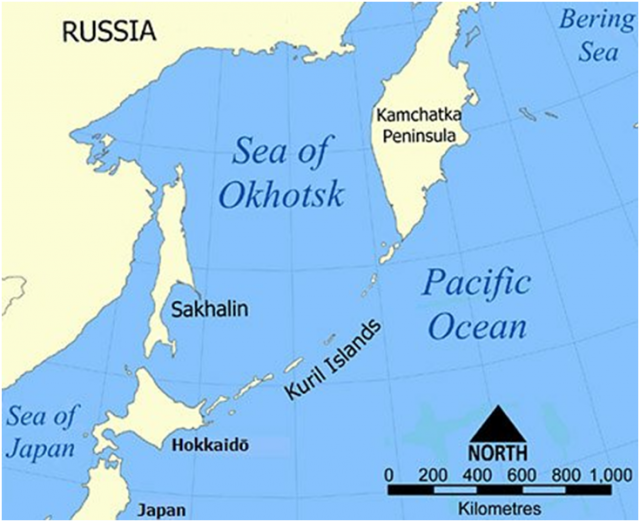Sakhalin Island
SAKHALIN IS THE LARGEST island of the Russian Federation, 589 mi (948 km) long and 16 to 105 mi (25 to 170 km) wide, with an area of 24,560 square mi (78,000 square km). Sakhalin is separated from the mainland by the narrow and shallow Mamiya Strait or Strait of Tartary, which often freezes in winter in its narrower part, and from HOKKAIDO (JAPAN) by the Soya Strait.
The island's orography and geological structure are imperfectly known. Two parallel ranges of mountains traverse it from north to south, reaching 2,000 to 5,000 ft (600 to 1,500 m). The Western Sakhalin Mountains peak with Mt. Ichara, at 4,860 ft (1,481 m), while the Eastern Sakhalin Mountain's highest peak is Mt. Lopatin (5,279 ft or 1,609 m), which is also the island's highest mountain. Tym-Poronaiskaya Valley separates the two ranges. Susuanaisky and Tonino-Anivsky ranges traverse the island in the south, while the Northern Sakhalin plain occupies most of its north.

Crystalline rocks crop out at several capes; cretaceous limestones, containing an abundant and specific fauna of gigantic ammonites, occur at Dui on the west coast; and tertiary conglomerates, sandstones, marls, and clays, folded by subsequent upheavals, appear in many parts of the island. The clays, which contain layers of good coal and abundant fossil vegetation, show that during the Miocene period Sakhalin formed part of a continent that comprised northern Asia, ALASKA and Japan and enjoyed a comparatively warm climate. The Pliocene deposits contain a mollusk fauna more arctic than that which exists at the present time.
The island's main rivers include the Tym, 250 mi (400 km) long and navigable by rafts and light boats for 50 mi (80 km), which flows north and northeast with numerous rapids and shallows and enters the Sea of Okhotsk. The Poronai River flows south-southeast to the Gulf of Patience or Shichiro Bay, on the southeast coast. Three other small streams enter the wide semicircular Gulf of Aniva or Higashifushimi Bay at the southern extremity of the island.
Influenced by the raw, foggy Sea of Okhotsk, the climate is very cold with temperature reaching to -49 degrees F (-45 degrees C). The rainfall averages 22 in (57 cm). Thick clouds for the most part shut out the sun, while the cold current from the Sea of Okhotsk, aided by northeast winds, brings immense icefloes to the east coast in summer. The whole of the island is covered with dense forests, mostly coniferous. Bears, foxes, otters, and sables are numerous, as are reindeer in the north, and musk deer, hares, squirrels, rats, and mice everywhere. The rivers swarm with fish, especially species of salmon (Oncorhynchus). Numerous whales visit the seacoast. Sealions, seals, and dolphins are a source of profit.
At the beginning of the 20th century, some 32,000 Russians inhabited Sakhalin, along with several thousand native inhabitants. The island's population has grown to 673,100 today, 83 percent of whom are ethnic Russians. The native inhabitants consist of some 2,000 Nivkhs, 1,300 Ainus, 750 Orochons, 200 Evenks, and some Yakuts. The Gilyaks in the north support themselves by fishing and hunting. The Ainus inhabit the south part of the island.
The capital of Sakhalin is Yuzhno Sakhalinsk (Japanese: Toyohara), a city of about 200,000 that has a large Korean minority who immigrated to the island by their free will or were brought for compulsory service during World War II, to work in the coal mines. The 400,000 Japanese inhabitants of Sakhalin were deported following the conquest of the southern portion of the island by the Soviet Union in 1945 at the end of World War II.